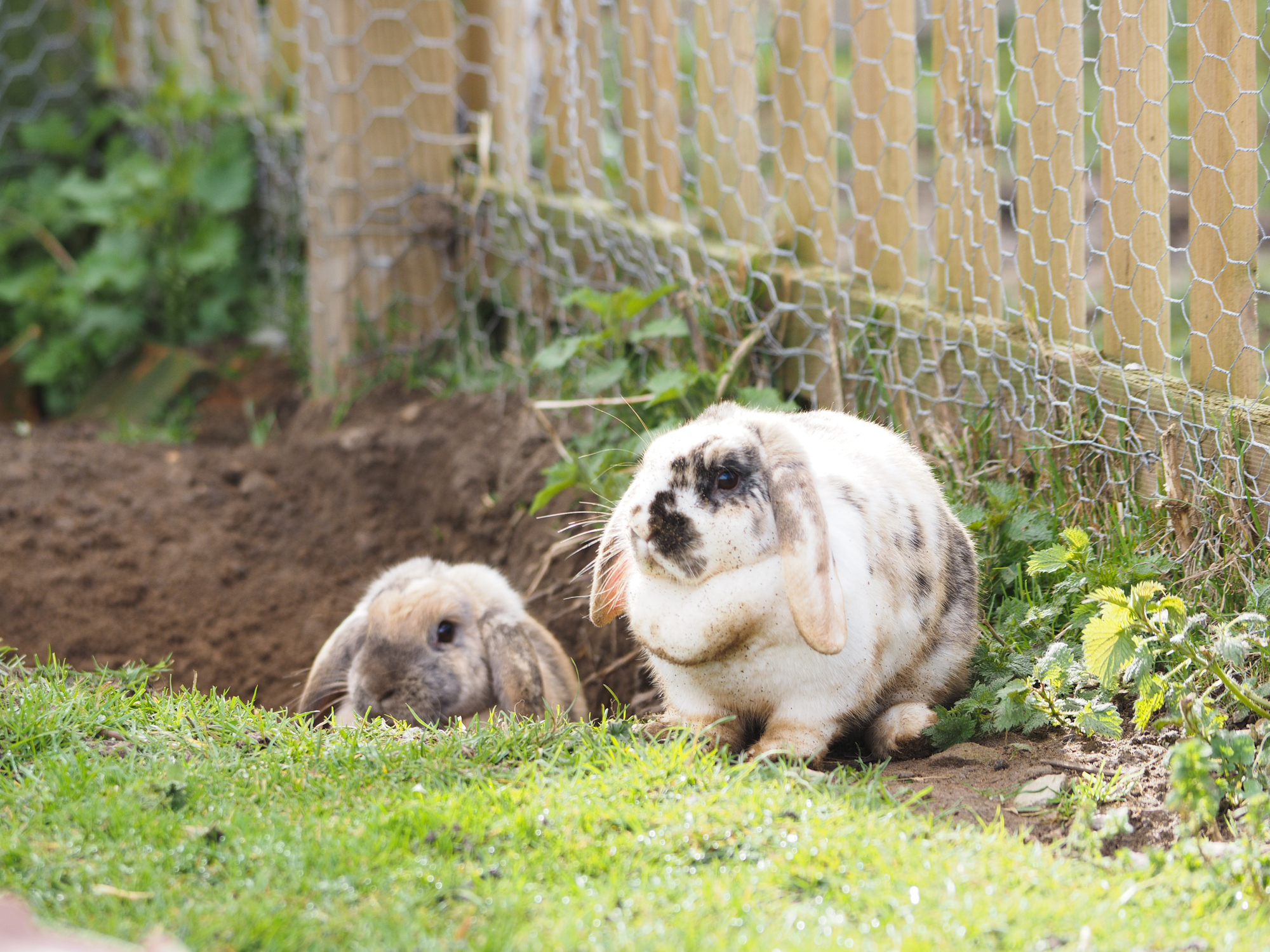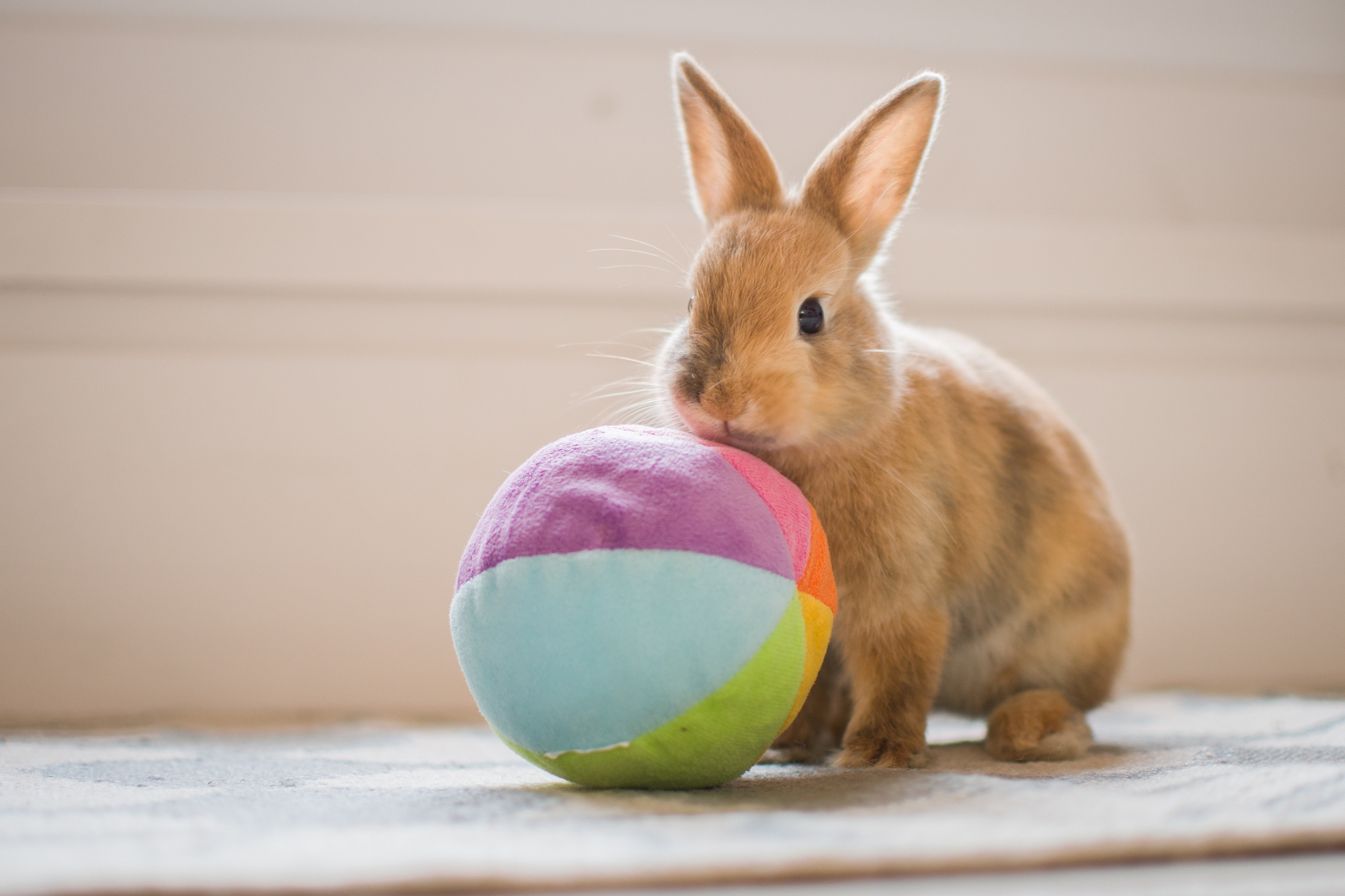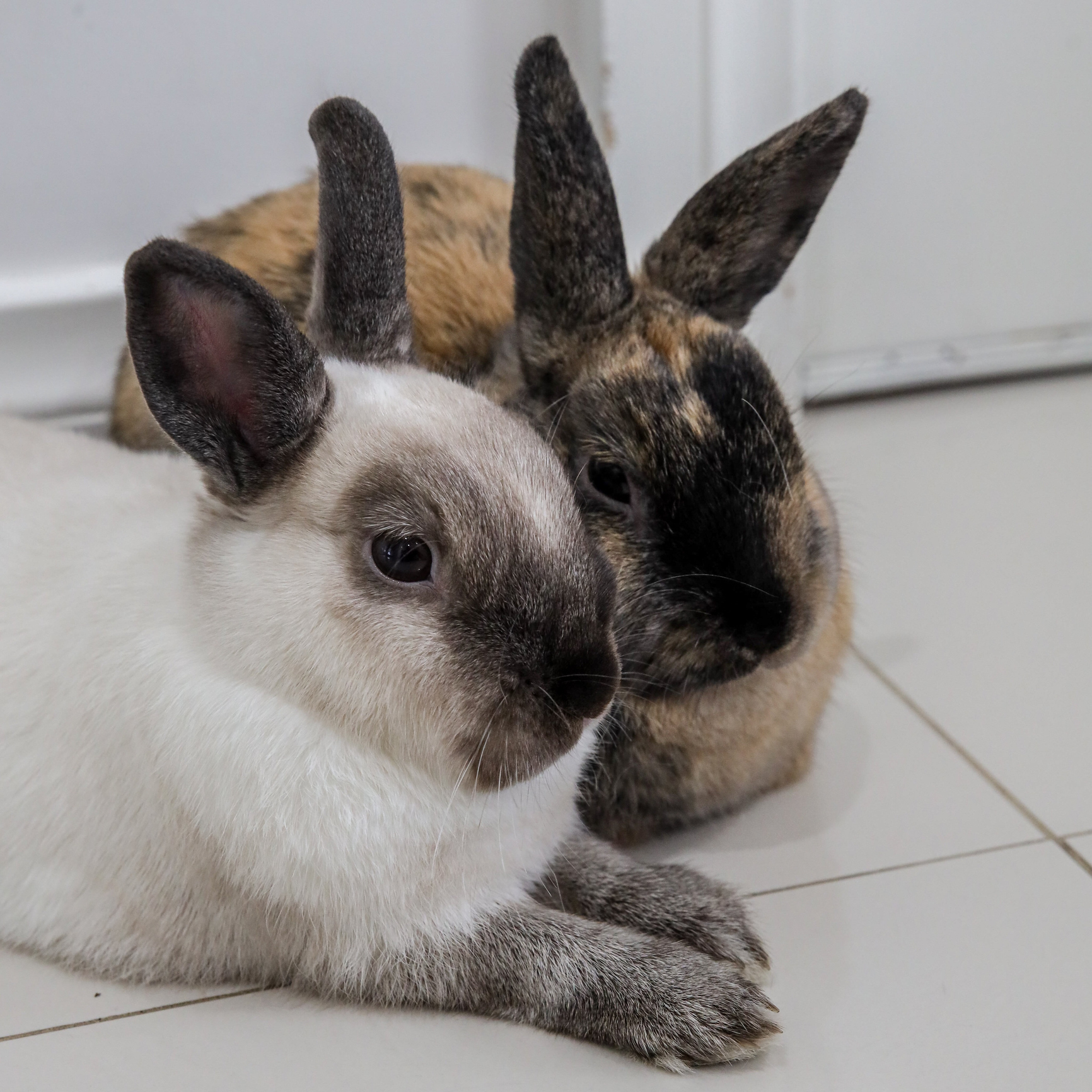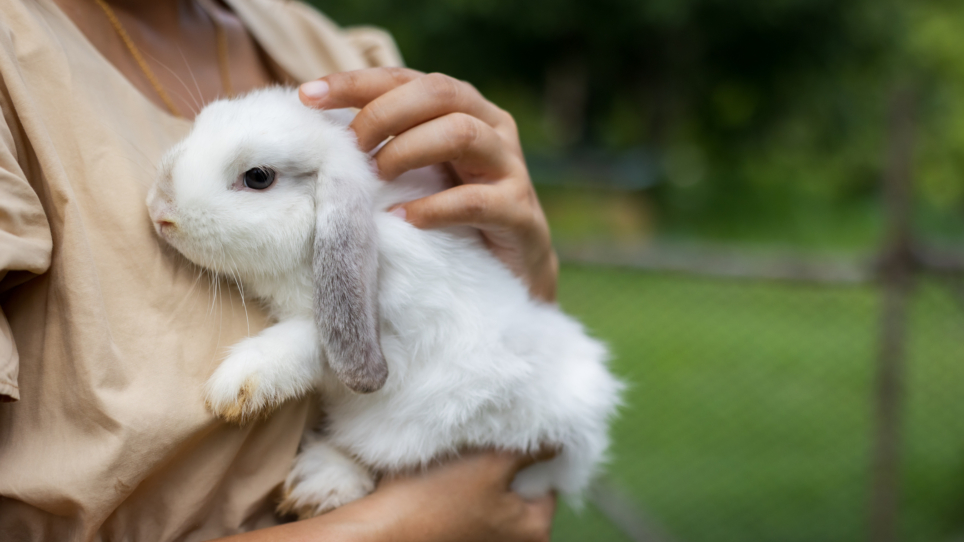Rabbits are inquisitive, intelligent and social animals who have their own individual personalities, ways of communicating and emotional intelligence. A rabbit’s welfare is intrinsically linked to how well they can cope with their environment – they need to feel safe, while avoiding boredom and stress. Environmental enrichment will provide your rabbit with a variety of activities designed to encourage their natural behaviours. It is especially important to provide ongoing enrichment if you leave your rabbit for long periods of the day (more than 4 hours at a time) on its own. Here are some practical ways to make your rabbit happier.
Housing
Here at AWL, we recommend that rabbits should be housed inside as part of the family. Rabbits should have access to a hutch somewhere in the house and should be allowed to roam free under supervision for enrichment and play. Create hiding places and platforms in their hutch. All rabbits, whether wild or domesticated, are instinctively always on their guard about being hunted or harmed. A simple upturned cardboard box will serve as somewhere to hide when your rabbit feels afraid. It will also serve as a bedroom if your hutch does not feature a private compartment. Rabbits love comfort, so line the box with soft bedding. Put untreated wooden logs in their enclosure, on which a rabbit can gnaw, climb and explore.
To encourage your rabbit to explore and exercise, build a larger pen on to your rabbit’s existing housing. An exercise run with a large floor area and a high ceiling will allow your rabbit to run, jump, hop, climb and rear up on their hind legs, all of which are normal behaviours. You should regularly inspect your rabbit’s housing to make sure that it is in good condition and there are no gaps through which animals such as foxes, cats or snakes can enter.
If your rabbit lives inside, you must also give them time and space to roam. Rabbits instinctively love to explore but also to chew! Ensure that electrical cords and curtain pulls are out of the way, or your bunny can chew them. You can build or purchase a pen for indoors, which can be dismantled when not in use. Rabbits like to explore toy tunnels, like those made for cats. Small cat trees offer rabbits the opportunity to climb up and inspect their surroundings so that they feel in control of their environment. Wild rabbits will often seek out higher ground to see what is going on around them.
The need to dig
All rabbits possess an instinct to dig. Wild rabbits will dig to excavate burrows and tunnels in order to construct a warren, which is their communal housing. To stimulate this bunny behaviour, provide an artificial sandpit. This could be by providing a digging box filled with rabbit litter. Your pet will really enjoy burrowing through this. A digging box is ideal for indoor rabbits too, who just can’t help themselves from trying to dig up and eat your carpet or get their paws into your pot plants.
You can also dig a little sandpit in your yard. To keep your rabbit safe, never fill it with sand. Sand can potentially clog a rabbit’s nasal passages, so fill the pit with litter or rabbit mulch instead. You will also need to inspect your rabbit’s exercise run to make sure that they have not started digging an escape tunnel!

Dietary enrichment and opportunities for foraging
A wild rabbit will spend much of their day seeking out potential sources of food. To inspire your rabbit to use their senses of smell and sight, you can encourage them to work for their food. For example:
- Fill a treat ball or the cup spaces in a cardboard coffee tray with little pieces of carrot or other bunny safe food.
- Stuff paper towel and toilet paper rolls with hay and greens.
- Fill the cups in an egg carton with bunny snacks.
- Hide leafy greens throughout their hutch, under hay and in hiding spots.
- You can buy foraging mats made of seagrass and hay, in which you can hide food. Foraging mats also give your rabbit an opportunity to dig.
Remember to accommodate any treats into their diet!
Play leads to good dental hygiene
Yes, rabbits like to play with toys! Dismiss the idea of the ‘dumb bunny’. Rabbits may be small, but your pet has a comparatively large brain. Rabbits love to investigate, manipulate and mark objects with their scent.
You can make or buy rabbit specific toys from pet shops or online. Toys or objects that benefit rabbits will foster chewing, foraging, jumping and even digging behaviours. Make sure that toys have smooth, rounded edges and that they are made of non-toxic materials. With all enrichment items you must regularly inspect them for damage and consider if there is any risk of injury to your pet. Repair, discard or replace any items that are broken or dangerous.
When rabbits become bored, their welfare suffers. You will need several toys that you rotate, as rabbits can become bored with them very quickly. Do not put all the toys in the hutch or pen and just leave them there. Rotate toys weekly. If you have more than one rabbit, ensure there are enough objects for everyone to play with, to stop your pets fighting or missing out.

Rabbit teeth never stop growing. They grow very quickly, like human fingernails. If your rabbit doesn’t file their teeth down on chew toys, they will develop dental issues. Lack of stimulation can lead to aggressive and destructive behaviours in rabbits, such as chewing your furniture or their housing. A rabbit can even destroy the wire on their hutch if they have nothing else to chew on. Rabbits are excellent escape artists so watch out for holes, as they can squeeze out of small gaps.
Rabbits like to chew on natural materials such as untreated wood, such as tree branches and tough cardboard. Rabbits enjoy the sensory experience of touching different textures. They love toys made from untreated rabbit-safe materials like woven seagrass, pinecones (clean these first), sisal, rattan, corn leaf, loofah, and raffia paper. Unpainted/unvarnished wooden toys are also good dental chews.
Inspect and remove any staples or tape when you give your rabbit a new cardboard box. This can be dangerous for your rabbit and cause digestive problems or injury. Avoid giving them boxes made of glossy, printed card, newspapers and other advertising materials which may contain toxic ink. If your rabbit seems to be eating a lot of cardboard, instead of their food, limit the amount that you give them, as cardboard has no nutritional value. Try introducing other types of chew toys instead.
Shredding paper is one of the simplest joys that a rabbit can experience, it can provide them with hours of entertainment. Rabbits enjoy tearing paper apart because of the crinkling noise it makes. They also love to burrow in and play with the shredded remains. Large pieces of pre-crumpled paper make simple but amazing toys for rabbits. Playing with a paper bag will also amuse your rabbit. Always cut off the bottom of the bag before you give it to them to prevent suffocation.
Similar in design to toys manufactured for young children, wooden activity tables are now available which encourage rabbits to learn to remove and push away wooden shapes that cover food hidden in compartments. Chewable, hanging toys can be suspended from the table. If you wish to make your own activity table from wood or cardboard, search for ideas online.
Remember not to give your rabbit anything too soft to chew on. They can also choke on toys with small, ingestible parts.
Somebunny to love
Rabbits are social animals who enjoy communal living. Inside a wild rabbit warren, passages are interconnected, and individual families live inside burrows. Consider adopting more than one rabbit, so they can provide each other with companionship and warmth.

Handling and socialisation
Contented rabbits enjoy positive interactions with their humans. Regular grooming will help your bunny get used to being handled and build a bond between the two of you.
You should never force your rabbit to interact with you. A rabbit will let you know when they want attention. They will approach you and can nudge you with their nose, which means in bunny language “Pet me please.” If you do not respond your rabbit may give you a gentle nip. They are not being aggressive; this gesture is just a rabbit’s way of getting your attention.
You can play games with your rabbit and even stage a bunny athletic event. Rabbits like to play games that cater to their natural tendencies and are rewarded with treats! Always supervise these activities.
- Bunny bowling - A game of bunny bowling will appeal to your rabbit’s mischievous side. Set up some toy bowling pins and watch as your buns nose-bonk them all down.
- Throwing games – Some rabbits love to pick up toys with their teeth and toss them with a flick of their head. Small cat toys are ideal for this activity because rabbits can easily grip them. Or provide cardboard tubes stuffed with hay for a ‘Highland bunny’ caber toss experience.
- Hopping challenge - Build a low wall out of cardboard boxes, and encourage your buns to hop over them by repeating the word “hop” and holding a treat in front of them. When they make the leap, reward them with the treat and lots of praise.
- Ball rolling – Roll a small cat ball with a bell in it towards your rabbit. After your rabbit has examined the ball, repeat the roll. After a while, you rabbit may start to bat the ball around with their nose or pick it up with their teeth. If they enjoy this activity, after a few sessions, your pet may even return the ball to you.
Music time
Rabbits have excellent hearing and they fear loud or sudden noises as this can signal the arrival of a predator. However, some owners will play classical or soft music to enhance their pet’s wellbeing.
Clicker training
It is also possible to train your rabbit using positive rewards-based methods, such as clicker training. Sometimes a rabbit will require a few sessions to get used to the sound of the clicker and to associate the click with the treat. Other rabbits understand right away. Rabbits frighten easily so keep the clicker initially in a pocket, under a shirt, or behind your back, so the sound is muffled.
Your rabbit needs to learn that a click means something good is about to happen. At first you can click every time that you feed them the treat. Soon they will associate the click with the food reward.
Once this association is established, you can wait for your rabbit’s desired behaviour. As soon as they do it, use the clicker. This will signal to your rabbit that they are about to get a treat.
Never push a rabbit to perform. It must be your rabbit who decides to behave in a particular way. Encourage natural behaviours. For example, a rabbit will stand on their hind legs to look around. Click the instant they stand on their hind legs, then give out a treat.
Precise timing is important. If you miss the moment and you click too late or too early, you must still treat. If you miss your pet performing the desired behaviour, it is better to not click at all and try again later.
Have you ever wondered what you should be feeding your rabbit? Head to our blog to find out!
